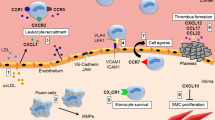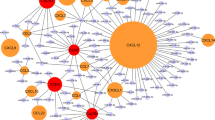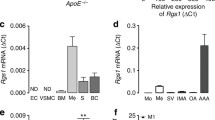Abstract
The cytokine macrophage migration inhibitory factor (MIF) is a unique pro-inflammatory regulator of many acute and chronic inflammatory diseases. In the pathogenesis of atherosclerosis, chronic inflammation of the arterial wall characterized by chemokine-mediated influx of leukocytes plays a central role. The contribution of MIF to atherosclerotic vascular disease has come into focus of many studies in recent years. MIF is highly expressed in macrophages and endothelial cells of different types of atherosclerotic plaques, and functional studies established the contribution of MIF to lesion progression and plaque inflammation. This proatherogenic effect may partly be explained by the finding that MIF regulates inflammatory cell recruitment to lesion areas. Similar to chemokines, MIF induces integrin-dependent arrest and transmigration of monocytes and T cells. These chemokine-like functions are mediated through interaction of MIF with the chemokine receptors CXCR2 and CXCR4 as a non-canonical ligand. In atherogenic monocyte recruitment, MIF-induced monocyte adhesion involves CD74 and CXCR2, which form a signaling receptor complex. In addition to lesion progression, MIF has been implicated in plaque destabilization, since MIF is predominantly expressed in vulnerable plaques and can induce collagen-degrading matrix metalloproteinases. The latter could be a relevant mechanism in atherosclerotic abdominal aneurysm formation, where MIF expression is correlated with aneurysmal expansion. In summary, MIF has been identified as an important regulator of atherosclerotic vascular disease with exceptional chemokine-like functions. Detailed analysis of the interaction of MIF with its receptors could provide valuable information for drug development for the anti-inflammatory treatment of established and unstable atherosclerosis.


Similar content being viewed by others
Abbreviations
- MIF:
-
macrophage migration inhibitory factor
- CXCR2:
-
receptor for chemokines with an CXC motif (CXCL1, -2, -3, -8)
- CXCR4:
-
receptor for the CXC chemokine CXCL12
- CD74:
-
Invariant γ-chain of class II histocompatibility antigens
- CXCL1:
-
chemokine ligand with a CXC motif; alternative titles: growth-regulated oncogene protein (GRO)-α, keratinocyte-derived chemokines (KC, mouse homolog)
- CXCL8:
-
chemokine ligand with a CXC motif; alternative title: interleukin-8
- CCL5:
-
chemokine ligand with a CC motif; alternative title: Regulated upon activation, normally T-expressed, and secreted (RANTES)
- JAB-1:
-
jun-c activation domain-binding protein; binds intracellular MIF
- AP-1:
-
activator protein-1; transcription factor involved in cellular proliferation, transformation and death
- PDGF:
-
platelet-derived growth factor; affects migration and differentiation of smooth muscle cells
- LDL-R−/− :
-
Low-density-Lipoprotein receptor deficient mice; develop hyperlipidemia and atherosclerosis on cholesterol-rich diet
- ApoE−/− :
-
Apolipoprotein E-deficient mice; develop hyperlipidemia and atherosclerosis on cholesterol-rich diet
- P-c-jun:
-
Phosphorylated c-jun transcription factor which activates AP-1 expression
- C-EBP-β:
-
CCAAT/Enhancer-binding protein-β; transcription factor which determines expression of many Interleukin 6-dependent genes
- αLβ2- integrin:
-
Heterodimeric leukocyte cell adhesion molecule with a β2- und αL subunit also referred to as leukocyte functional antigen (LFA)-1 or CD18/CD11c
- α4β1-integrin:
-
Heterodimeric leukocyte cell adhesion molecule with a β1- und α4 subunit also referred to as very late activation protein (VLA)-4 or CD29/CD49d
- CXCL12:
-
Chemokine ligand with a CXC motif, also known as stromal cell-derived factor (SDF)-1
- CXCR1:
-
receptor for chemokines with a CXC motif (e.g. CXCL6, -8)
- CXCR3:
-
receptor for chemokines with a CXC motif (e.g. CXCL9, -10, -11)
- THP-1:
-
monocytic cell line derived from a patient with acute monocytic leukemia
- MMP-1, -2, -9:
-
matrix metalloproteinases; Zn2+-binding endopeptidases that degrade various components of the extracellular matrix
References
Mackay J, Mensah G (2004) The Atlas of heart disease and stroke. World Health Organization, Geneva
Ross R (1993) The pathogenesis of atherosclerosis: a perspective for the 1990s. Nature 362:801–809
Libby P (2002) Inflammation in atherosclerosis. Nature 420:868–874
Hansson GK (2005) Inflammation, atherosclerosis, and coronary artery disease. N Engl J Med 352:1685–1695
Tedgui A, Mallat Z (2006) Cytokines in atherosclerosis: pathogenic and regulatory pathways. Physiol Rev 86:515–581
Weber C, Schober A, Zernecke A (2004) Chemokines: key regulators of mononuclear cell recruitment in atherosclerotic vascular disease. Arterioscler Thromb Vasc Biol 24:1997–2008
Weber C (2003) Novel mechanistic concepts for the control of leukocyte transmigration: specialization of integrins, chemokines, and junctional molecules. J Mol Med 81:4–19
Laudanna C, Alon R (2006) Right on the spot. Chemokine triggering of integrin-mediated arrest of rolling leukocytes. Thromb Haemost 95:5–11
Bernhagen J, Calandra T, Mitchell RA, Martin SB, Tracey KJ, Voelter W, Manogue KR, Cerami A, Bucala R (1993) MIF is a pituitary-derived cytokine that potentiates lethal endotoxaemia. Nature 365:756–759
Bernhagen J, Bacher M, Calandra T, Metz CN, Doty SB, Donnelly T, Bucala R (1996) An essential role for macrophage migration inhibitory factor in the tuberculin delayed-type hypersensitivity reaction. J Exp Med 183:277–282
Calandra T, Roger T (2003) Macrophage migration inhibitory factor: a regulator of innate immunity. Nat Rev Immunol 3:791–800
Bernhagen J, Calandra T, Bucala R (1998) Regulation of the immune response by macrophage migration inhibitory factor: biological and structural features. J Mol Med 76:151–161
Donnelly SC, Bucala R (1997) Macrophage migration inhibitory factor: a regulator of glucocorticoid activity with a critical role in inflammatory disease. Mol Med Today 3:502–507
Sun HW, Bernhagen J, Bucala R, Lolis E (1996) Crystal structure at 2.6-A resolution of human macrophage migration inhibitory factor. Proc Natl Acad Sci U S A 93:5191–5196
Degryse B, de Virgilio M (2003) The nuclear protein HMGB1, a new kind of chemokine? FEBS Lett 553:11–17
Lin SG, Yu XY, Chen YX, Huang XR, Metz C, Bucala R, Lau CP, Lan HY (2000) De novo expression of macrophage migration inhibitory factor in atherogenesis in rabbits. Circ Res 87:1202–1208
Calandra T, Bernhagen J, Mitchell RA, Bucala R (1994) The macrophage is an important and previously unrecognized source of macrophage migration inhibitory factor. J Exp Med 179:1895–1902
Burger-Kentischer A, Goebel H, Seiler R, Fraedrich G, Schaefer HE, Dimmeler S, Kleemann R, Bernhagen J, Ihling C (2002) Expression of macrophage migration inhibitory factor in different stages of human atherosclerosis. Circulation 105:1561–1566
Kleemann R, Hausser A, Geiger G, Mischke R, Burger-Kentischer A, Flieger O, Johannes FJ, Roger T, Calandra T, Kapurniotu A, Grell M, Finkelmeier D, Brunner H, Bernhagen J (2000) Intracellular action of the cytokine MIF to modulate AP-1 activity and the cell cycle through Jab1. Nature 408:211–216
Ahn JD, Morishita R, Kaneda Y, Lee SJ, Kwon KY, Choi SY, Lee KU, Park JY, Moon IJ, Park JG, Yoshizumi M, Ouchi Y, Lee IK (2002) Inhibitory effects of novel AP-1 decoy oligodeoxynucleotides on vascular smooth muscle cell proliferation in vitro and neointimal formation in vivo. Circ Res 90:1325–1332
Chen Z, Sakuma M, Zago AC, Zhang X, Shi C, Leng L, Mizue Y, Bucala R, Simon D (2004) Evidence for a role of macrophage migration inhibitory factor in vascular disease. Arterioscler Thromb Vasc Biol 24:709–714
Schober A, Bernhagen J, Thiele M, Zeiffer U, Knarren S, Roller M, Bucala R, Weber C (2004) Stabilization of atherosclerotic plaques by blockade of macrophage migration inhibitory factor after vascular injury in apolipoprotein e-deficient mice. Circulation 109:380–385
Schwartz RS, Topol EJ, Serruys PW, Sangiorgi G, Holmes DR Jr. (1998) Artery size, neointima, and remodeling: time for some standards. J Am Coll Cardiol 32:2087–2094
Bittl JA (1996) Advances in coronary angioplasty. N Engl J Med 335:1290–1302
Schober A, Weber C (2005) Mechanisms of monocyte recruitment in vascular repair after injury. Antioxid Redox Signal 7:1249–1257
Schober A, Karshovska E, Zernecke A, Weber C (2006) SDF-1alpha-mediated tissue repair by stem cells: a promising tool in cardiovascular medicine? Trends Cardiovasc Med 16:103–108
Schober A, Knarren S, Lietz M, Lin EA, Weber C (2003) Crucial role of stromal cell-derived factor-1alpha in neointima formation after vascular injury in apolipoprotein E-deficient mice. Circulation 108:2491–2497
Schwartz SM, deBlois D, O'Brien ER (1995) The intima. Soil for atherosclerosis and restenosis. Circ Res 77:445–465
Schwartz RS, Holmes DR Jr., Topol EJ (1992) The restenosis paradigm revisited: an alternative proposal for cellular mechanisms. J Am Coll Cardiol 20:1284–1293
Thiele M, Bernhagen J (2005) Link between macrophage migration inhibitory factor and cellular redox regulation. Antioxid Redox Signal 7:1234–1248
Schober A, Zernecke A, Liehn EA, von Hundelshausen P, Knarren S, Kuziel WA, Weber C (2004) Crucial role of the CCL2/CCR2 axis in neointimal hyperplasia after arterial injury in hyperlipidemic mice involves early monocyte recruitment and CCL2 presentation on platelets. Circ Res 95:1125–1133
Schrans-Stassen BH, Lue H, Sonnemans DG, Bernhagen J, Post MJ (2005) Stimulation of vascular smooth muscle cell migration by macrophage migration inhibitory factor. Antioxid Redox Signal 7:1211–1216
Korshunov VA, Nikonenko TA, Tkachuk VA, Brooks A, Berk BC (2006) Interleukin-18 and macrophage migration inhibitory factor are associated with increased carotid intima-media thickening. Arterioscler Thromb Vasc Biol 26:295–300
Pan JH, Sukhova GK, Yang JT, Wang B, Xie T, Fu H, Zhang Y, Satoskar AR, David JR, Metz CN, Bucala R, Fang K, Simon DI, Chapman HA, Libby P, Shi GP (2004) Macrophage migration inhibitory factor deficiency impairs atherosclerosis in low-density lipoprotein receptor-deficient mice. Circulation 109:3149–3153
Paigen B, Holmes PA, Mitchell D, Albee D (1987) Comparison of atherosclerotic lesions and HDL-lipid levels in male, female, and testosterone-treated female mice from strains C57BL/6, BALB/c, and C3H. Atherosclerosis 64:215–221
Burger-Kentischer A, Gobel H, Kleemann R, Zernecke A, Bucala R, Leng L, Finkelmeier D, Geiger G, Schaefer HE, Schober A, Weber C, Brunner H, Rutten H, Ihling C, Bernhagen J (2006) Reduction of the aortic inflammatory response in spontaneous atherosclerosis by blockade of macrophage migration inhibitory factor (MIF). Atherosclerosis 184:28–38
Mitchell RA, Liao H, Chesney J, Fingerle-Rowson G, Baugh J, David J, Bucala R (2002) Macrophage migration inhibitory factor (MIF) sustains macrophage proinflammatory function by inhibiting p53: regulatory role in the innate immune response. Proc Natl Acad Sci U S A 99:345–350
Hudson JD, Shoaibi MA, Maestro R, Carnero A, Hannon GJ, Beach DH (1999) A proinflammatory cytokine inhibits p53 tumor suppressor activity. J Exp Med 190:1375–1382
Mercer J, Figg N, Stoneman V, Braganza D, Bennett MR (2005) Endogenous p53 protects vascular smooth muscle cells from apoptosis and reduces atherosclerosis in ApoE knockout mice. Circ Res 96:667–674
Bernhagen J, Krohn R, Lue H, Gregory JL, Zernecke A, Koenen RR, Dewor M, Georgiev I, Schober A, Leng L, Kooistra T, Fingerle-Rowson G, Ghezzi P, Kleemann R, McColl SR, Bucala R, Hickey MJ, Weber C (2007) MIF is a noncognate ligand of CXC chemokine receptors in inflammatory and atherogenic cell recruitment. Nat Med 13:587–596
Herder C, Illig T, Baumert J, Muller M, Klopp N, Khuseyinova N, Meisinger C, Martin S, Thorand B, Koenig W (2008) Macrophage migration inhibitory factor (MIF) and risk for coronary heart disease: Results from the MONICA/KORA Augsburg case-cohort study, 1984–2002. Atherosclerosis (in press)
Boisvert WA, Rose DM, Johnson KA, Fuentes ME, Lira SA, Curtiss LK, Terkeltaub RA (2006) Up-regulated expression of the CXCR2 ligand KC/GRO-alpha in atherosclerotic lesions plays a central role in macrophage accumulation and lesion progression. Am J Pathol 168:1385–1395
Zernecke A, Bot I, Talab YD, Shagdarsuren E, Bidzhekov K, Meiler S, Krohn R, Schober A, Sperandio M, Soehnlein O, Bornemann J, Tacke F, Biessen EA, Weber C (2007) Protective role of CXC receptor 4/CXC ligand 12 unveils the importance of neutrophils in atherosclerosis. Circ Res 102:209–217
Leng L, Metz CN, Fang Y, Xu J, Donnelly S, Baugh J, Delohery T, Chen Y, Mitchell RA, Bucala R (2003) MIF signal transduction initiated by binding to CD74. J Exp Med 197:1467–1476
Shi X, Leng L, Wang T, Wang W, Du X, Li J, McDonald C, Chen Z, Murphy JW, Lolis E, Noble P, Knudson W, Bucala R (2006) CD44 is the signaling component of the macrophage migration inhibitory factor-CD74 receptor complex. Immunity 25:595–606
Roscic-Mrkic B, Fischer M, Leemann C, Manrique A, Gordon CJ, Moore JP, Proudfoot AE, Trkola A (2003) RANTES (CCL5) uses the proteoglycan CD44 as an auxiliary receptor to mediate cellular activation signals and HIV-1 enhancement. Blood 102:1169–1177
Huo Y, Weber C, Forlow SB, Sperandio M, Thatte J, Mack M, Jung S, Littman DR, Ley K (2001) The chemokine KC, but not monocyte chemoattractant protein-1, triggers monocyte arrest on early atherosclerotic endothelium. J Clin Invest 108:1307–1314
Poznansky MC, Olszak IT, Foxall R, Evans RH, Luster AD, Scadden DT (2000) Active movement of T cells away from a chemokine. Nat Med 6:543–548
Lue H, Thiele M, Franz J, Dahl E, Speckgens S, Leng L, Fingerle-Rowson G, Bucala R, Luscher B, Bernhagen J (2007) Macrophage migration inhibitory factor (MIF) promotes cell survival by activation of the Akt pathway and role for CSN5/JAB1 in the control of autocrine MIF activity. Oncogene 26:5046–5059
Hristov M, Zernecke A, Bidzhekov K, Liehn EA, Shagdarsuren E, Ludwig A, Weber C (2007) Importance of CXC chemokine receptor 2 in the homing of human peripheral blood endothelial progenitor cells to sites of arterial injury. Circ Res 100:590–597
Zernecke A, Schober A, Bot I, von Hundelshausen P, Liehn EA, Mopps B, Mericskay M, Gierschik P, Biessen EA, Weber C (2005) SDF-1alpha/CXCR4 axis is instrumental in neointimal hyperplasia and recruitment of smooth muscle progenitor cells. Circ Res 96:784–791
Lan HY, Bacher M, Yang N, Mu W, Nikolic-Paterson DJ, Metz C, Meinhardt A, Bucala R, Atkins RC (1997) The pathogenic role of macrophage migration inhibitory factor in immunologically induced kidney disease in the rat. J Exp Med 185:1455–1465
Gregory JL, Morand EF, McKeown SJ, Ralph JA, Hall P, Yang YH, McColl SR, Hickey MJ (2006) Macrophage migration inhibitory factor induces macrophage recruitment via CC chemokine ligand 2. J Immunol 177:8072–8079
Kong YZ, Yu X, Tang JJ, Ouyang X, Huang XR, Fingerle-Rowson G, Bacher M, Scher LA, Bucala R, Lan HY (2005) Macrophage migration inhibitory factor induces MMP-9 expression: implications for destabilization of human atherosclerotic plaques. Atherosclerosis 178:207–215
Johnson JL, George SJ, Newby AC, Jackson CL (2005) Divergent effects of matrix metalloproteinases 3, 7, 9, and 12 on atherosclerotic plaque stability in mouse brachiocephalic arteries. Proc Natl Acad Sci U S A 102:15575–15580
Kong YZ, Huang XR, Ouyang X, Tan JJ, Fingerle-Rowson G, Bacher M, Mu W, Scher LA, Leng L, Bucala R, Lan HY (2005) Evidence for vascular macrophage migration inhibitory factor in destabilization of human atherosclerotic plaques. Cardiovasc Res 65:272–282
Pearce E, Tregouet DA, Samnegard A, Morgan AR, Cox C, Hamsten A, Eriksson P, Ye S (2005) Haplotype effect of the matrix metalloproteinase-1 gene on risk of myocardial infarction. Circ Res 97:1070–1076
Schmeisser A, Marquetant R, Illmer T, Graffy C, Garlichs CD, Bockler D, Menschikowski D, Braun-Dullaeus R, Daniel WG, Strasser RH (2005) The expression of macrophage migration inhibitory factor 1alpha (MIF 1alpha) in human atherosclerotic plaques is induced by different proatherogenic stimuli and associated with plaque instability. Atherosclerosis 178:83–94
Shimizu K, Mitchell RN, Libby P (2006) Inflammation and cellular immune responses in abdominal aortic aneurysms. Arterioscler Thromb Vasc Biol 26:987–994
Pan JH, Lindholt JS, Sukhova GK, Baugh JA, Henneberg EW, Bucala R, Donnelly SC, Libby P, Metz C, Shi GP (2003) Macrophage migration inhibitory factor is associated with aneurysmal expansion. J Vasc Surg 37:628–635
Verschuren L, Lindeman JH, van Bockel JH, Abdul-Hussien H, Kooistra T, Kleemann R (2005) Up-regulation and coexpression of MIF and matrix metalloproteinases in human abdominal aortic aneurysms. Antioxid Redox Signal 7:1195–1202
Author information
Authors and Affiliations
Corresponding author
Rights and permissions
About this article
Cite this article
Schober, A., Bernhagen, J. & Weber, C. Chemokine-like functions of MIF in atherosclerosis. J Mol Med 86, 761–770 (2008). https://doi.org/10.1007/s00109-008-0334-2
Received:
Revised:
Accepted:
Published:
Issue Date:
DOI: https://doi.org/10.1007/s00109-008-0334-2




